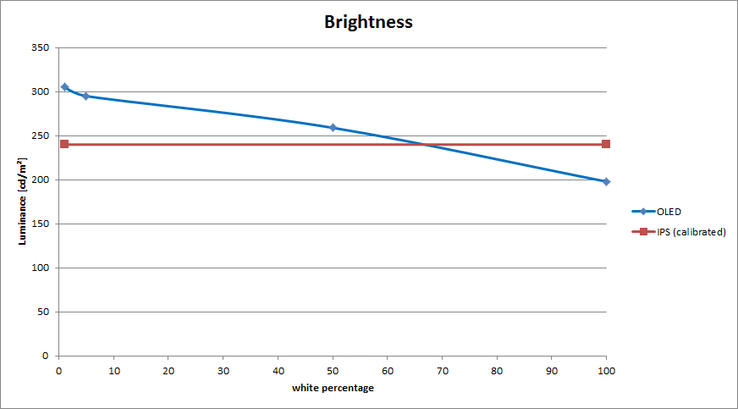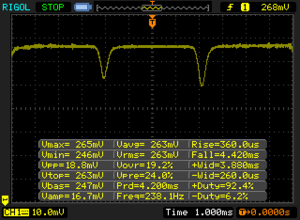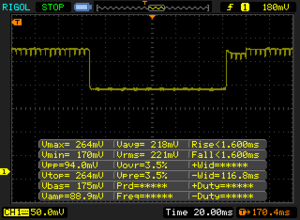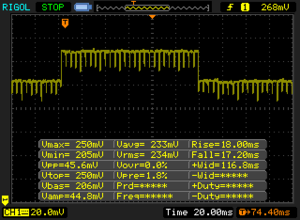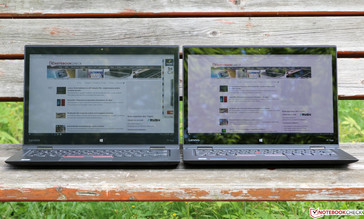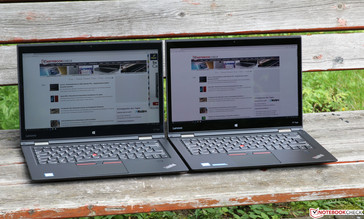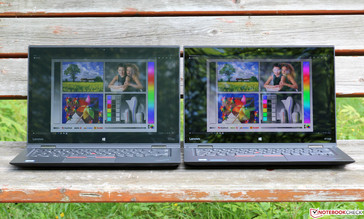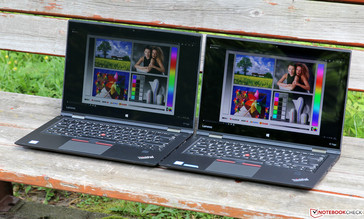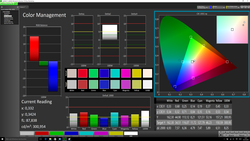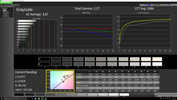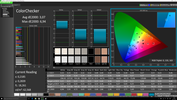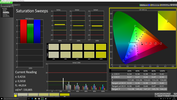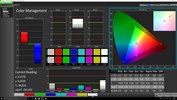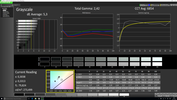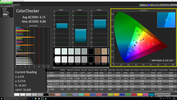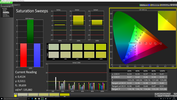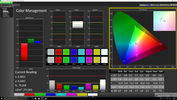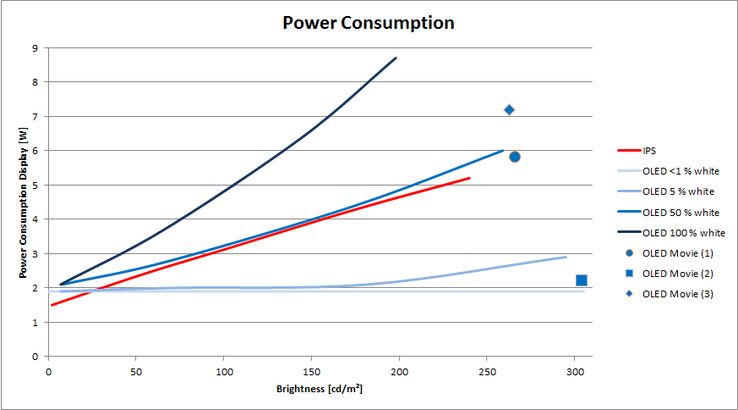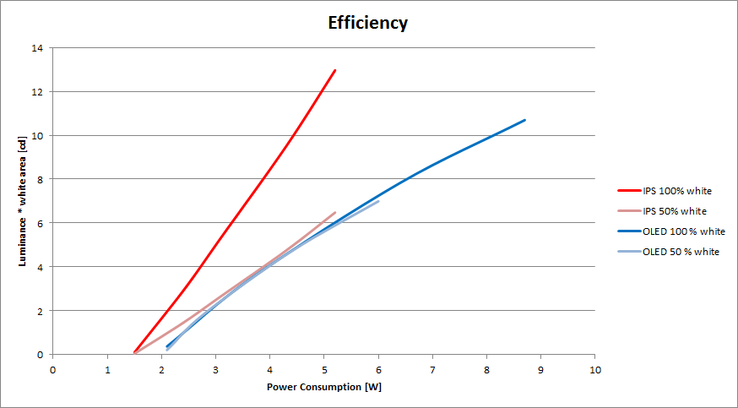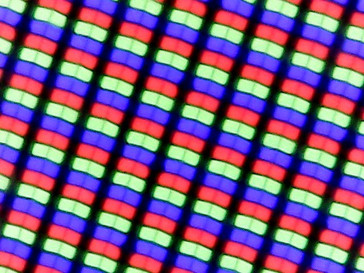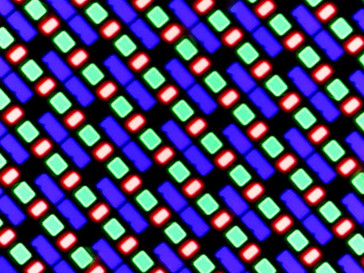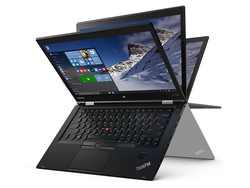Display Comparison: OLED vs. IPS on Notebooks

For the original German article, see here.
The technology isn't exactly new: OLED displays are based on light-emitting organic diodes and have been used for smartphones, tablets and TVs for a few years now. So far, notebooks have been the exception, which has technical reasons as well as financial ones.
That's changing, however, as several notebook manufactures - Lenovo, Alienware, and HP among them - have announced OLED notebooks for 2016. The first candidate on our test bench is the Lenovo ThinkPad X1 Yoga, which normally ships with an IPS panel, but can be upgraded to an OLED display (same WQHD resolution of 2560 x 1440 pixels) for 300 Euro (~$330) more. If that's worth it and what advantages and disadvantages each configuration offers is the subject of our review.
Many thanks to the online shop campuspoint.de, as they have provided both ThinkPad X1 Yoga models for our review.
Why OLED?
Before we look at the individual measurements, we want to talk about OLED technology in general. While normal displays are basically filters which pass through the light emitting - from the always active - (LED) backlight for each individual pixel in a particular intensity and color, the pixels that make up an OLED display are their own source of light. There are numerous advantages to this approach:
- black areas have no remaining brightness
- the darker the display gets, the less power it consumes
- viewing angle stability is excellent
- the color gamut is very wide
- response time is very short
- the lack of a backlight means very slim displays
As always, there are drawbacks - in this case, there are four potential issues with OLED displays:
- maximum brightness is limited
- expensive to produce
- screen burn-in is possible
- aging behavior
We are going to attempt to clarify if and in what manner OLED notebook displays are affected by the above drawbacks.
Brightness and Distribution
As we've mentioned briefly before, the backlight of a LCD is always set to a constant brightness (some TV dimming techniques are the exception). A white area is therefore always uniformly bright, no matter if it's the entire picture or just a small section.
OLED displays are different: since all sub-pixels have to be at their maximum intensity for the picture to be bright and white, the power draw increases significantly in that scenario. To keep the power consumption in check and to increase the life expectancy (which hinges on the temperature and the brightness), manufactures usually vary the luminance according to the display content.
The ThinkPad X1 Yoga behaves in the above manner: while the IPS panel (LG LP140QH1) shows a constant brightness of 250 cd/m², the OLED version (Samsung ATNA40JU01) fluctuates between 198 and 305 cd/m² depending on the situation. We recorded the highest value when only a small white field (< 1 % of the area) was displayed on a black background, while an entirely white background resulted in the lowest value. We measured from 240 to 260 cd/m² during word processing or web browsing. Our standardized measurement using the i1Profiler software (40 % white) resulted in a solid 277 cd/m².
We can alleviate all concerns that this adjustment is disruptive in any way: it appears that the display regulates so quickly and steplessly that even abrupt changes aren't noticeable to the human eye at all. The manner in which this happens definitely has nothing in common with the CABC-technology (Content Adaptive Brightness Control) which both the Dell Latitude 7370 and XPS 13 utilize.
OLED Display
| |||||||||||||||||||||||||
Brightness Distribution: 91 %
Center on Battery: 279 cd/m²
Contrast: ∞:1 (Black: 0 cd/m²)
ΔE ColorChecker Calman: 5.15 | ∀{0.5-29.43 Ø4.78}
ΔE Greyscale Calman: 5.44 | ∀{0.09-98 Ø5}
100% sRGB (Argyll 1.6.3 3D)
98% AdobeRGB 1998 (Argyll 1.6.3 3D)
Gamma: 2.28
CCT: 5686 K
IPS Display
| |||||||||||||||||||||||||
Brightness Distribution: 82 %
Center on Battery: 268 cd/m²
Contrast: 791:1 (Black: 0.34 cd/m²)
ΔE ColorChecker Calman: 4.73 | ∀{0.5-29.43 Ø4.78}
ΔE Greyscale Calman: 5.3 | ∀{0.09-98 Ø5}
90.38% sRGB (Argyll 1.6.3 3D)
58.86% AdobeRGB 1998 (Argyll 1.6.3 3D)
65.9% AdobeRGB 1998 (Argyll 3D)
90.5% sRGB (Argyll 3D)
65.2% Display P3 (Argyll 3D)
Gamma: 2.42
CCT: 6854 K
PWM and Response Times
Since the individual pixels of an OLED display never reach their theoretical maximum brightness, the luminance has to be adjusted using PWM, which in this case happens at a frequency of 240 Hz. Subjectively, we didn't notice any flickering whatsoever, but some sensitive users experience problems like headaches or nausea when working on notebooks equipped with standard LCD displays, which also use PWM.
Screen Flickering / PWM (Pulse-Width Modulation)
| Screen flickering / PWM detected | 240 Hz | ≤ 100 % brightness setting | |
The display backlight flickers at 240 Hz (worst case, e.g., utilizing PWM) Flickering detected at a brightness setting of 100 % and below. There should be no flickering or PWM above this brightness setting. The frequency of 240 Hz is relatively low, so sensitive users will likely notice flickering and experience eyestrain at the stated brightness setting and below. In comparison: 53 % of all tested devices do not use PWM to dim the display. If PWM was detected, an average of 8108 (minimum: 5 - maximum: 343500) Hz was measured. | |||
The response times of an OLED panel are generally in the realm of micro-seconds, so they are much faster than their LCD-sibling and not susceptible to streaking. For that reason, the ThinkPad X1 Yoga could be a perfect gaming notebook – if it wasn't for the rather dismal performance of the integrated HD Graphics 520. The gaming rigs from MSI, Schenker and Asus would certainly benefit from the OLED-technology; so far, only Alienware Dell Alienware 13 R2: OLED Variante in den USA verfügbarhas announced a model with this type of display.
Since the black/white and gray response times are so short, our measurement tools can't accurately capture them. The graphics below thus only constitute a reference point.
Display Response Times
| ↔ Response Time Black to White | ||
|---|---|---|
| 1 ms ... rise ↗ and fall ↘ combined | ↗ 0.5 ms rise | |
| ↘ 0.5 ms fall | ||
| The screen shows very fast response rates in our tests and should be very well suited for fast-paced gaming. In comparison, all tested devices range from 0.1 (minimum) to 240 (maximum) ms. » 3 % of all devices are better. This means that the measured response time is better than the average of all tested devices (20.2 ms). | ||
| ↔ Response Time 50% Grey to 80% Grey | ||
| 1 ms ... rise ↗ and fall ↘ combined | ↗ 0.5 ms rise | |
| ↘ 0.5 ms fall | ||
| The screen shows very fast response rates in our tests and should be very well suited for fast-paced gaming. In comparison, all tested devices range from 0.165 (minimum) to 636 (maximum) ms. » 3 % of all devices are better. This means that the measured response time is better than the average of all tested devices (31.6 ms). | ||
Contrast and Viewing Angles
The black areas of high-end IPS panels still emit light at one one-thousandth of the backlight-luminance - so at 300 cd/m², that's still accounts for about 0.3 cd/m². OLED displays on the other hand are in an entirely different league: the manufacturer claims a contrast ratio of 2000000:1. The resulting black value 0.00015 cd/m² is too low to be measured or confirmed by the naked eye: in a completely dark room, black is simply black - and that even at maximum brightness.
What doesn't appear that exciting at first, actually has quite an impact during everyday use: in dimmer environments, an OLED display looks more saturated, more vivid and live-like than any IPS panel could. In completely dark surroundings, the difference is quite dramatic when watching movie scenes with lots of contrast: even the best IPS displays depict blacks as slightly gray, but OLED displays don't show any differences, so the black bars on top are not noticeable in a completely dark scene. The picture floats seamlessly in space and the resulting immersion is simply phenomenal. Movies like Star Trek, Interstellar or Gravity almost look better on the 14-inch Yoga then they do on an LCD TV three times the size. The following picture of a Star Wars scene unfortunately can only show that to a limited extent, as neither our camera nor normal displays are able of adequately reproducing the dynamic range an OLED display is capable of.
When looking at the display at an angle, another advantage of the OLED-technology becomes apparent. IPS panels generally have good viewing angle stability and the colors usually remain stable when viewing the display from the side - but both the brightness as well as the contrast ratio take a hit. OLED panels, on the other hand, remain as vivid as before and the brightness only decreases marginally. From about 45 degrees, an OLED display (124 cd/m² at 50 % white) is about twice as bright as its IPS counterpart (at 60 cd/m²) – an advantage which not only has its benefits when watching movies, but also during regular productivity tasks.
Outdoor Use
Even though the most significant advantage of the OLED-technology is the perfect black value, the panels also do very well in bright daylight. Even though the maximum brightness of 240 cd/m² is nearly identical, the notebookcheck.net homepage is easier to see on an OLED display, particularly because the panel reflects less of the ambient light and therefore has a higher "real" contrast ratio. The IPS version looks more pale and not quite as clear. One advantage of Thinkpad with the LCD panel is that reflections are more diffuse - the OLED display is a highly reflective "glare-type", while the IPS version could be called "semi-matte".
Outdoor usage (left: IPS, right: OLED)
Color Reproduction
As far as the colors are concerned, "eye-catching" hits the nail on the head - such vivid colors are a rarity among IPS displays. This is not to say that the panel looks overly saturated - even at high saturation levels of 80 and 100 %, the differences are still noticeable. At times, the color gamut surpasses the very demanding AdobeRGB standard - for example for the colors red, yellow, and magenta.
The higher saturation would be an issue while working in the smaller sRGB color space, so Lenovo supplies different color profiles, which can be selected via right-clicking on the desktop. In addition to the default option ("Native"), there is another one called "Standard" (roughly corresponding with the sRGB color space) and "Photo Pro" (approximately equivalent to the AdobeRGB color space). Although the color temperature is a little too low in either case, the presets certainly produce respectable results, as the average DeltaE-deviations of 3.1 (ColorChecker sRGB) respectively 3.8 (ColorChecker AdobeRGB) clearly show.
Unfortunately we weren't able to improve the results via a calibration. The profiles we created during our attempts all exhibited a bluish cast and lightening of darker areas - likely a software issue, since the panel should lend itself to a calibration quite nicely thanks to the outstanding color gamut.
Power Consumption and Efficiency
To determine the power consumption and efficiency of both the IPS and OLED displays, we recorded the differences between an active and inactive display for various usage scenario for each of the notebooks.
The IPS panel shows a nearly linear correlation between power consumption and brightness. At 2 cd/m² we showed a consumption of about 1.5 watts, at 150 cd/m² about 3.9 watts and at 240 cd/m² about 5.2 watts. As we mentioned before, this is independent of the display content.
For the OLED display we measured a slightly higher minimum consumption of 1.9 watts, which fluctuated according to brightness as well as the content. As long as the percentage of white areas is minimal, even raising the display brightness to 300 cd/m² doesn't really affect the power requirements, while a completely white background at 198 cd/m² resulted in a healthy power draw of 8.7 watts.
During browsing and word processing tasks, 50 to 70 % white on average is realistic in our opinion. Taking into account that the OLED display consumes about as much as the IPS display only at 45 % and below, the user consequently can expect a shorter battery life. Watching movies can result in the opposite: depending on the situation - take a look at the scene "Movie (2)" from Star Wars below - the OLED display can actually be the more efficient and should be at least equal to the IPS display.
If we only take the areas into consideration which are actually lit and determine the "candelas per watt" for both technologies, it becomes clear that the OLED display operates at a near-constant efficiency. The LCD panel is a lot more efficient when only white is displayed, but it gives up the advantage as the number of dark pixels increases.
Is the OLED panel truly less efficient when displaying only white? Not necessarily: "luminance" describes light emittance in a certain direction - during our tests, normally at a right angle to the display. Since an OLED panel has outstanding viewing angle stability and emits more light in other directions than an IPS display would, the luminous flux is actually quite a bit higher - and the overall efficiency better than the measurements indicate.
Burn-in and Aging
Static elements - for example the task bar or various menu bars - are quite common when operating a Windows computer, so burn-in and memory effects could potentially be an issue. During our review period (spanning several days) we did not encounter any apparent afterglow as a result of contrast-rich display contents. We can only hope that the display will remain unaffected even after years of usage at high brightness levels.
Another potential issue typical for OLED displays is the aging of the pixels, which happens at a different rate for each color (red, green, and blue). Samsung and other manufactures aim to prevent that by using different subpixel sizes, so the load matches the aging process. Commonly, the rather delicate blue subpixels are the largest ones, which can clearly be seen in the microscope image below. What can't be prevented is the steady decrease of the brightness over the life span of the display, which for current OLED TVs is around 30 to 50 % in 20000 usage hours. For our Thinkpad this means that intensive use (8 hours per day) could potentially result in a display that's only half as bright after 7 years time.
Verdict
Notebooks displays based on OLED-technology are a significant leap forward in quality: while TN and IPS displays differ in their contrast ratio by a factor of two to five, an OLED display can outperform other LCD panels by a factor of one thousand - and offers a perfect black value as a result. Combined with an extensive color gamut, the picture quality is now at levels not seen before.
The advantages of OLED displays don't end here: thanks to the extremely fast response times, the technology seems to be ideally suited for powerful gaming notebooks and professional graphics workstations, since the additional costs (when viewed as an increase in percent) come less into play. The small disadvantage in power consumption we observed when comparing the OLED-version of the ThinkPad X1 business notebook to the IPS is much less noticeable when the screen content is predominantly dark and/or colorful. We shouldn't forget either that the higher power draw is a direct result of the much better viewing angle stability.
We can't really comment on the long-term durability yet. If we take the particulars of comparable TV displays and transfer them onto the Yoga, it shouldn't be too much of an issue down the line - also keeping in mind that Lenovo picked a high-end ThinkPad model with a longer warranty as their trailblazer for the technology.
At the end, it's likely going to be the additional cost which might prevent the breakthrough of OLED displays for a few more years. Once the the price difference drops to around 100 Euro (~$110) though, there is no real argument to be made for traditional LCDs - especially in the upper and high-end segment.




